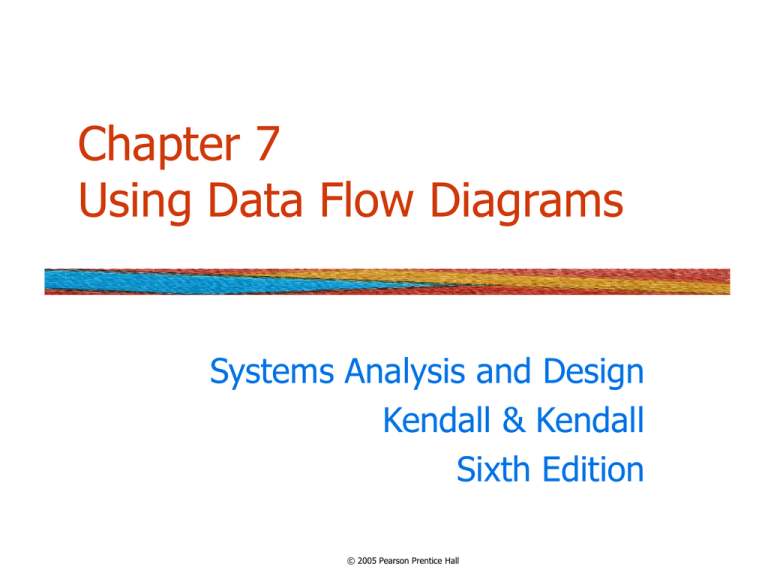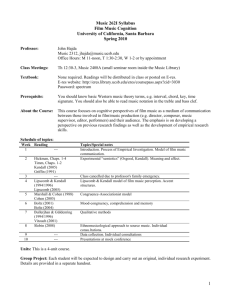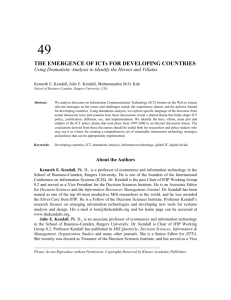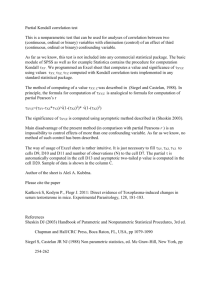
Chapter 7
Using Data Flow Diagrams
Systems Analysis and Design
Kendall & Kendall
Sixth Edition
© 2005 Pearson Prentice Hall
Major Topics
• Data flow diagram symbols
• Data flow diagram levels
• Creating data flow diagrams
• Physical and logical data flow diagrams
• Partitioning
• Event driven modeling
• Use case and data flow diagrams
Kendall & Kendall
© 2005 Pearson Prentice Hall
7-2
Thu 15-4 Data Flow Diagrams
• DFDs are one of the main methods
available for analyzing data-oriented
systems.
• DFDs emphasize the logic underlying
the system.
• The systems analysts can put together
a graphical representation of data
movement through the organization.
Kendall & Kendall
© 2005 Pearson Prentice Hall
7-3
Advantages of the Data Flow
Diagram Approach
Four advantages over narrative
explanations of data movement:
• Freedom from committing to the technical
implementation too early.
• Understanding of the interrelationships of
systems and subsystems.
• Communicating current system knowledge
to users.
• Analysis of the proposed system.
Kendall & Kendall
© 2005 Pearson Prentice Hall
7-4
Basic Symbols
Four basic symbols are:
• A double square for an external entity--a
source or destination of data.
• An arrow for movement of data from one
point to another.
• A rectangle with rounded corners for the
occurrence of transforming process.
• An open-ended rectangle for a data store.
Kendall & Kendall
© 2005 Pearson Prentice Hall
7-5
Basic Symbols
Kendall & Kendall
© 2005 Pearson Prentice Hall
7-6
External Entities
• Represent people or organizations
outside of the system being studied
• Shows the initial source and final
recipient of data and information
• Should be named with a noun,
describing that entity
Customer
Kendall & Kendall
© 2005 Pearson Prentice Hall
7-7
External Entities (Continued)
• External entities may be:
• A person, such as CUSTOMER or STUDENT.
• A company or organization, such as BANK
or SUPPLIER.
• Another department within the company,
such as ORDER FULFILLMENT.
• Another system or subsystem, such as the
INVENTORY CONTROL SYSTEM.
Kendall & Kendall
© 2005 Pearson Prentice Hall
7-8
Processes
• Represent either:
1
Add New
Customer
• A whole system
• A subsystem
• Work being done, an activity
2
Customer
Inquiry
Subsystem
• Names should be in the form verbadjective-noun
• The exception is a process that represents
an entire system or subsystem.
Kendall & Kendall
© 2005 Pearson Prentice Hall
7-9
Data Stores
• Name with a noun, describing the data
• Data stores are usually given a unique
reference number, such as D1, D2, D3.
• Include any data stored, such as:
• A computer file or database.
• A transaction file .
• A set of tables .
D1
• A manual file of records.
Kendall & Kendall
© 2005 Pearson Prentice Hall
Customer
Master
7-10
New Customer
Data Flow
•
•
•
•
Customer Record
Data flow shows the data about a person,
place, or thing that moves through the
system.
Names should be a noun that describes the
data moving through the system.
Arrowhead indicates the flow direction.
Use double headed-arrows only when a
process is reading data and updating the data
on the same table or file.
Kendall & Kendall
© 2005 Pearson Prentice Hall
7-11
Sun 18-4 Developing Data
Flow Diagrams
Use the following guidelines:
• Create the context level diagram, including all
•
•
Kendall & Kendall
external entities and the major data flow to or
from them.
Create Diagram 0 by analyzing the major activities
within the context process.
• Include the external entities and major data stores.
Create a child diagram for each complex process
on Diagram 0.
© 2005 Pearson Prentice Hall
7-12
Figure 7.3 Context diagram
Kendall & Kendall
© 2005 Pearson Prentice Hall
7-13
Figure 7.3 Note the greater
detail in diagram 0
Kendall & Kendall
© 2005 Pearson Prentice Hall
7-14
Creating Data Flow Diagrams
Detailed data flow diagrams may be
developed by:
• Making a list of business activities.
• Analyzing what happens to an input data
flow from an external entity.
(is data input to several processes? Is it stored)
• Analyzing what is necessary to create an
output data flow to an external entity.
(Backwards- where it comes from? Calculated or not – ex paychecks)
Kendall & Kendall
© 2005 Pearson Prentice Hall
7-15
Creating Data Flow Diagrams
Detailed data flow diagrams may be
developed by (continue):
• Examining the data flow to or from a data
store.
• Analyzing a well-defined process for data
requirements and the nature of the
information produced. (What input it needs)
• Noting and investigating unclear areas.
(may need follow-up interviews)
Kendall & Kendall
© 2005 Pearson Prentice Hall
7-16
Wed 21-7 Data Flow Diagram
Levels
• Data flow diagrams are built in layers.
• The top level is the Context level.
• Each process may explode to a lower
level.
• The lower level diagram number is the
same as the parent process number.
• Processes that do not create a child
diagram are called primitive.
Kendall & Kendall
© 2005 Pearson Prentice Hall
7-17
Context-Level Data Flow
Diagram
• It contains only one process,
representing the entire system.
• The process is given the number zero.
• All external entities are shown on the
context diagram as well as major data
flow to and from them.
• The diagram does not contain any data
stores.
Kendall & Kendall
© 2005 Pearson Prentice Hall
7-18
Kendall & Kendall
© 2005 Pearson Prentice Hall
7-19
Kendall & Kendall
© 2005 Pearson Prentice Hall
7-20
Kendall & Kendall
© 2005 Pearson Prentice Hall
7-21
Kendall & Kendall
© 2005 Pearson Prentice Hall
7-22
Kendall & Kendall
© 2005 Pearson Prentice Hall
7-23
Diagram 0
• Diagram 0 is the explosion of the
context level diagram.
• It should include up to 7 or 9 processes.
• Any more will result in a cluttered diagram.
• Processes are numbered with an
integer.
• The major data stores and all external
entities are included on Diagram 0.
Kendall & Kendall
© 2005 Pearson Prentice Hall
7-24
Child Diagrams
•
•
•
Each process on diagram zero may be
exploded to create a child diagram.
Each process on a lower-level diagram may
be exploded to create another child diagram.
These diagrams found below Diagram 0 are
given the same number as the parent
process.
• Process 3 would explode to Diagram 3.
Kendall & Kendall
© 2005 Pearson Prentice Hall
7-25
3.2
Edit
Customer
Child Diagrams (Continued)
5.2.7
Calculate
Customer
Discount
• Each process is numbered with the
parent diagram number, a period, and a
unique child diagram number.
• Examples are:
• 3.2 on Diagram 3, the child of process 3.
• 5.2.7 on Diagram 5.2, child of process 5.2.
• On Diagram 3, the processes would be
numbered 3.1, 3.2, 3.3 and so on.
Kendall & Kendall
© 2005 Pearson Prentice Hall
7-26
Child Diagrams (Continued)
• External entities are usually not shown
on the child diagrams below Diagram 0.
• If the parent process has data flow
connecting to a data store, the child
diagram may include the data store as
well.
Kendall & Kendall
© 2005 Pearson Prentice Hall
7-27
Child Diagrams (Continued)
• A lower-level diagram may contain data
stores not shown on the parent process,
such as:
• A file containing a table of information
(such as a tax table).
• A file linking two processes on the child
diagram.
• Minor data flow, such as an error line,
may be included on a child diagram.
Kendall & Kendall
© 2005 Pearson Prentice Hall
7-28
Child Diagrams (Continued)
• An interface data flow is data that are
input or output from a child diagram
that matches the parent diagram data
flow.
• Processes that do not create a child
diagram are called primitive processes.
• Logic is written for these processes.
Kendall & Kendall
© 2005 Pearson Prentice Hall
7-29
Tue 20-10 Data Flow Diagram
Errors
• The following conditions are errors that
occur when drawing a data flow
diagram:
• A process with only input data flow or
only output data flow from it.
2
Add
New
Customer
1
Add
New
Customer
Kendall & Kendall
© 2005 Pearson Prentice Hall
7-30
Data Flow Diagram Errors
(Continued)
• Data stores or external entities are
connected directly to each other, in any
combination.
Customer
D1
Customer
Vendor
D2
Vendor Master
Kendall & Kendall
© 2005 Pearson Prentice Hall
7-31
Data Flow Diagram Errors
(Continued)
• Incorrectly labeling data flow or objects
• Examples are:
• Labels omitted from data flow or objects.
• Data flow labeled with a verb.
• Processes labeled with a noun.
• Too many processes on a data flow
diagram.
• Nine is the suggested maximum.
Kendall & Kendall
© 2005 Pearson Prentice Hall
7-32
Data Flow Diagram Errors
(Continued)
• Omitting data flow from the diagram
• Unbalanced decomposition between a
parent process and a child diagram
• The data flow in and out of a parent
process must be present on the child
diagram.
Kendall & Kendall
© 2005 Pearson Prentice Hall
7-33
Tue 8-12 Logical Data Flow
Diagrams
• Logical data flow diagrams show how
the business operates.
• They have processes that would exist
regardless of the type of system
implemented.
Kendall & Kendall
© 2005 Pearson Prentice Hall
7-34
Data Flow Diagram
Progression
The progression of creating data flow
diagrams is:
• Create a logical DFD of the current system.
• Next add all the data and processes not in
the current system that must be present in
the new system.
• Finally derive the physical data flow
diagram for the new system.
Kendall & Kendall
© 2005 Pearson Prentice Hall
7-35
Data Flow
Diagram
Progression
Kendall & Kendall
© 2005 Pearson Prentice Hall
7-36
Logical Data Flow Diagrams
Advantages
Advantages of logical DFDs are:
• Better communication with users.
• More stable systems, since the design is based on
•
•
•
Kendall & Kendall
a business framework, not on a particular technology.
Increased understanding of the business by
analysts.
The system will have increased flexibility and be
easier to maintain.
Elimination of redundancy.
© 2005 Pearson Prentice Hall
7-37
Thu 22-7 Physical Data Flow
Diagrams
•
Physical data flow diagrams show how the system
operates or how the new system will be implemented.
Physical data flow diagrams include:
• Clarifying which processes are manual and which are
automated.
• Describing processes in greater detail.
• Sequencing processes in the order they must be
executed.
•
•
•
Kendall & Kendall
Temporary data stores and transaction files.
Specifying actual document and file names.
Controls to ensure accuracy and completeness.
© 2005 Pearson Prentice Hall
7-38
Logical and Physical Data Flow
Diagrams
•
Logical
• Focuses on the business and how the business
•
•
•
operates
Not concerned with how the system will be
constructed
Describes the business events that take place and
the data required and produced by each event
Physical
• Shows how the system will be implemented
• Depicts the system
Kendall & Kendall
© 2005 Pearson Prentice Hall
7-39
Figure 7.10 Physical data flow diagrams
contain many items not found in logical data
flow diagrams
Kendall & Kendall
© 2005 Pearson Prentice Hall
7-40
Kendall & Kendall
© 2005 Pearson Prentice Hall
7-41
Thu 22-4 CRUD
• Physical data flow diagrams include
processes for adding, reading,
changing, and deleting records.
• CRUD is an acronym for Create, Read,
Update, Delete.
• A CRUD matrix shows which programs
or processes add, read, update, or
delete master file records.
Kendall & Kendall
© 2005 Pearson Prentice Hall
7-42
Kendall & Kendall
© 2005 Pearson Prentice Hall
7-43
Transaction Files
• Master or transaction database tables or
files are used to link all processes that
operate at different times.
• They are required to store the data
from the process that creates the data
to the process that uses the data.
Kendall & Kendall
© 2005 Pearson Prentice Hall
7-44
Triggers and Events
• An input flow from an external entity is
sometimes called a trigger, since it
starts activities.
• Events cause the system to do
something.
• An approach used to create a data flow
fragment is to analyze events, which
are summarized in an event table.
Kendall & Kendall
© 2005 Pearson Prentice Hall
7-45
Event Response Tables
• An event table is used to create a data
flow diagram by analyzing each event
and the data used and produced by the
event.
• Every row in an event table represents
a unique activity and is used to create
one process on the data flow diagram.
Kendall & Kendall
© 2005 Pearson Prentice Hall
7-46
Kendall & Kendall
© 2005 Pearson Prentice Hall
7-47
Kendall & Kendall
© 2005 Pearson Prentice Hall
7-48
Mon 26-7 Use Case and Data
Flow Diagrams
• A use case is another approach used to
develop a data flow diagram.
• A use case is used to create a data flow
diagram by providing a framework for
obtaining processes, input, output, and
data stores required for user activities.
• A use case shows the steps performed
to accomplish a task.
Kendall & Kendall
© 2005 Pearson Prentice Hall
7-49
Use Case
The major sections of a use case are:
• Use case name.
• Description.
• Trigger.
• Trigger type.
• Input name and source.
• Output name and destination.
• Steps performed.
• Information required for each step.
Kendall & Kendall
© 2005 Pearson Prentice Hall
7-50
Kendall & Kendall
© 2005 Pearson Prentice Hall
7-51
Partitioning
• Partitioning is the process of analyzing a
data flow diagram and deriving a series
of manual procedures and computer
programs.
• A dashed line is drawn around a group
of processes that are included in each
computer program or manual
procedure.
Kendall & Kendall
© 2005 Pearson Prentice Hall
7-52
Reasons for Partitioning
• The reasons for partitioning a data flow
diagram into separate computer
programs are:
• Different user groups should have
different programs.
• Processes that execute at different times
must be in separate programs.
• Processes may be separated into different
programs for security.
Kendall & Kendall
© 2005 Pearson Prentice Hall
7-53
Reasons for Partitioning
(Continued)
•
•
Similar tasks may be included in the same
program.
Several batch processes may be included in
the same program for efficiency.
If the data flow into and out of a process is entirely computer information, the process is
called a batch process. Batch processes do not require any human intervention
•
Several processes may be included in the
same program or job stream for consistency
of data.
related programs that are run in a prescribed order. The output of one program is the input
to the next program and so on.
Kendall & Kendall
© 2005 Pearson Prentice Hall
7-54
Partitioning Web Sites
Web sites are partitioned into pages.
• Improves speed of processing
• Easier Web page maintenance
• Different pages when reading different
data
• Partitioned for security, separating pages
using a secure connection from those that
do not
Kendall & Kendall
© 2005 Pearson Prentice Hall
7-55
Communicating Using
Data Flow Diagrams
Data flow diagrams can be used for
several different purposes:
• Unexploded data flow diagrams are useful
to identify information requirements.
• Exploded data flow diagrams can be used
for presentation, education, and gathering
feedback information from users
• Meaningful labels should be used for good
communication.
Kendall & Kendall
© 2005 Pearson Prentice Hall
7-56







